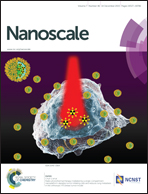Preparing non-volatile resistive switching memories by tuning the content of Au@air@TiO2-h yolk–shell microspheres in a poly(3-hexylthiophene) layer†
Abstract
Crystalline hybrid microspheres, encapsulating a Au nanocore in the hollow cavity of a hairy semiconductor TiO2 shell (Au@air@TiO2-h microspheres) were prepared using template-assisted synthesis methods. The as-prepared microspheres are dispersed into a poly(3-hexylthiophene) (P3HT) matrix and used as a memory active layer. The electrical rewritable memory effects of Al/[Au@air@TiO2-h + P3HT]/ITO sandwich devices can be effectively and exactly controlled by tuning the microsphere content in the electroactive layer. To clarify the switching mechanism, different components in the device, such as P3HT and the microspheres, have been investigated. And it was determined that the switching mechanism can be attributed to the formation and rupture of oxygen vacancy filaments. These results suggest that the Au@air@TiO2-h microspheres are potentially capable of high density data storage. In addition, this finding could provide important guidelines for the reproducibility of nanocomposite-based memory devices and is helpful to demonstrate the switching mechanism of these devices.


 Please wait while we load your content...
Please wait while we load your content...